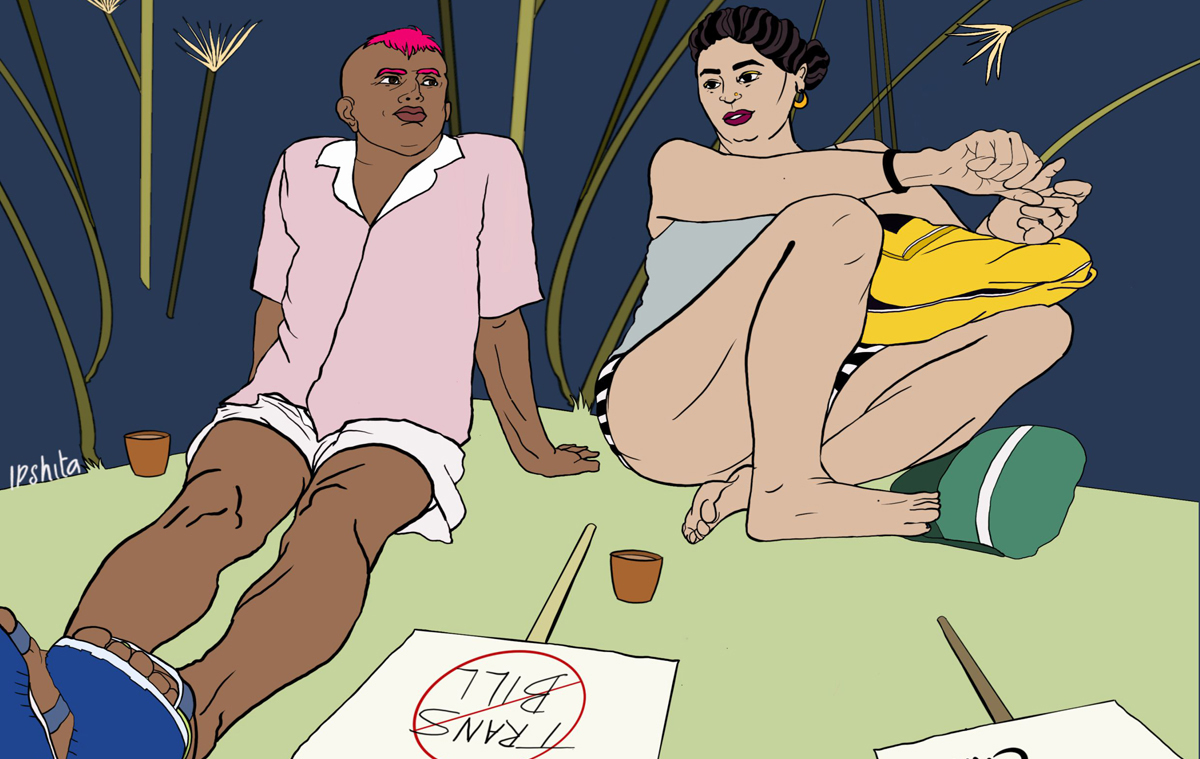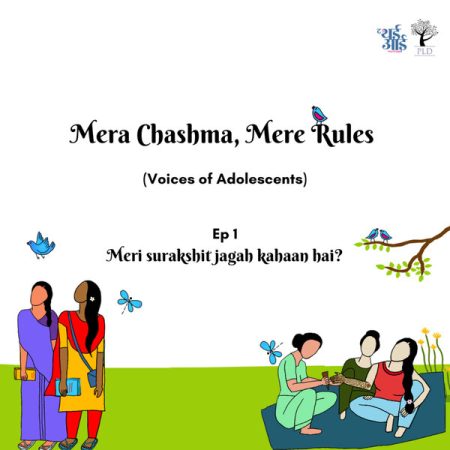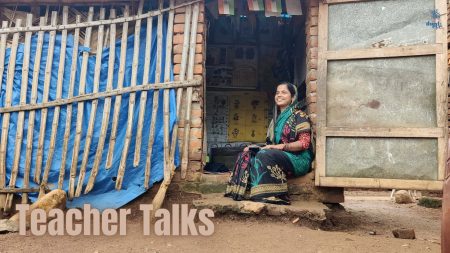Like us, perhaps you too find yourself wondering about the division of labour of work at home. Who does it? Could there be a way to separate the work of keeping a home from the gender identities it seemingly, ‘naturally’ encourages? If there was a recipe for making a happy home, do we only remember some ingredients such as love and gender and forget others such as power, convention and stereotypes? Here is part 2 of our exploration of queer households and work. (Read part 1 here.)
With inputs from Shamini Kothari.
Samhita is an asexual cis woman, and lives with her non-binary, queer partner. Mid-late 20s, Mumbai.
Samhita says, “My idea of a queer home has always been a domestic space where queer persons known to each other, and who have forged an emotional bond with each other, can come to, and just be themselves. A queer home is a place that gives you the acceptance and the camaraderie that you perhaps may not receive from your biological/adoptive/cisheteronormative family. I live in a queer home. I live here with Ekta, my partner, a sapphic non-binary person, our two dogs, and a rescue cat.”
Samhita and Ekta’s home in Mumbai is often bustling: friends come over for lunch or dinner, help out with chores and housework or watch the animals while Samhita and Ekta are away or occupied.
Samhita feels domestic labour can be a way of expressing that you have a stake in this shared life, and the wellbeing of those who are an inherent part of it, or indispensable to it. “The ‘terms of our relationship’ was probably one of the first things my partner and I talked about after the initial blushing and giggling.
I remember saying the words ‘equal distribution of labour!’ a lot in the beginning. In theory, we were both on the same page, but when it actually came down to it, the most organic parts of our relationship (in terms of how little effort it took us) were the highly gendered roles we took up.
My partner, as the more ‘masc’ between us, was the one who called the shots. I was the one who followed. We fell into this horrible borrowed pattern, until we noticed and resisted.”
Resisted, how?
Samhita says,“We talked about it. For one thing, we’re very aware of the mistakes our parents made and we don’t want to repeat them, or let that same bitterness invade our relationship. One of the reasons my parents had such a difficult time was because communication broke down between them entirely. My partner and I refuse to let that happen to us. So we start from there: we know how much our shared queer home means to both of us, so we absolutely have to meet its challenges.” So, they decided to fair things up. “When we moved into our flat, we had a family meeting and drew up a board of tasks, splitting things between us equally – from buying sabzis, to turning on the water pump, to paying the cleaning lady, to taking the dogs for a walk, to watering the plants and more.”
No home is ever made without guilt as one of its bricks, and Samhita too, felt she had to compensate for her partner’s natural ability to run a house. “Because I have not been raised in a conventional setting, or encouraged to learn conventionally feminine work like cooking, sewing, and various kinds of care work, I simply cannot bring these to the table. My gender has, in a sense, betrayed me here. Not because I believe a woman should be able to do these things, but because I’m so terrible at doing what a lot of other women do so well! Sometimes, I am jealous of my partner, and I keep wondering how she knows so much about running a house when the most I could do (for a looooong time) was make Maggi, and change my bed covers.” She pause, and muses a little,
“I’m asexual. And I don’t know if that impacts my role in the house. If there is anything about a household that is rooted in sexuality and sexual reproduction, then I suppose I’ve run that into the ground. But it doesn’t seem to have cropped up as a problem ever.”
So, how has Samhita done that?
“I love cleaning and organising. For me, all things have a specific place that they must be in and returned to after use. An orderly house is half my battle won against my anxiety. I can spend a whole afternoon folding laundry, dusting surfaces, arranging jars in the kitchen, segregating waste into different garbage bags. And, I’m often possessed by a need to clean. Two nights ago, I was up until three am, cleaning the bathroom tiles. It is solitary work. I get to see the results before me. And I get to be with my own thoughts.”
So, it’s not as simple as doing what you are good at?
“If we had decided labour based on what we were good at, the entire burden would have been on my partner. But part of us adulting together is about me slowly picking up things that she already knows how to do. Learning to take the pressure off her.”

Circling back, Samhita has managed to even queer her parents’ home. “I feel like the home where my biological family lives has also been transformed into a queer home, because of how I assert my identity as a sapphic asexual woman, and how my parents have come to accept and make room for that in our home. There is an understanding that questions about marrying a man and having children will not be tolerated by me, and my parents also respect and uphold that. My parents’ home was ‘queered’ the moment I came out. The existence of a queer person in a space meant that that space ceased to be cisheteronormative, at least it did where I grew up.”
Raj is non-binary and identifies as queer, and lives with their partner and one other person, who is also part of their family, in Mumbai.
“A queer home is a space created by people whose lived reality and felt experience is queer. This is built over time, and multiple negotiations by people who care for each other, who collaborate, who believe in consensus, who acknowledge and redistribute power, who are invested in the wellbeing of all the people in that home. For my context, this has been with chosen family.”
Raj’s home is the product of many, many years of negotiations. In one respect it seems like a carefully finished and idealized articulation, a way of thinking, speaking, and doing-together to aspire to. In another, though, it seems like an ongoing redefinition of ‘family’, a queer critique of hierarchy and silence around the work of home-making. As such, it is a work in progress.
“A queer home functions in the absence of a script, a structure and sanction that is normative. What holds a queer home together is the trust that people will hold each other through uncertainty and be willing to work with what organically unfolds.”
In the beginning, Raj preferred the term ‘significant otherness’ to family, which has been coded for millennia across cultures as an institution that perpetuates union between men and women for the purposes of reproduction and the retention of property. Families are hierarchical by nature, Raj reminds us, and the relationships within them are prescriptive. So, how do they negotiate work at home? “Most of the labour is skill-based and interest-based. We have caste and class privilege because of which some household tasks are not done by us. We are also able to purchase machinery such as washing machine and vacuum cleaner. The task which sees the most shared labour is care of our animals. Feeding them, cleaning up after them, vet visits, medication, exercise, playtime is something we engage in.
“Another reason for labour is love. To cook for a loved one is a good reason to do that labour. In such a case, the rule is the person who is cooking will get help to prep the food and doesn’t do cleanup. Ideally, someone else also puts out plates, etc. We do have responsibilities that one person takes on routinely, i.e., one of us cooks mainly, the provisions are all purchased by one person and coordination of upkeep – such as plumbing, electricity, Aquaguard filter, cleaning cat litter are all done by the third person. We largely stick to these responsibilities. Some tasks are more individual – such as washing the car – which is a labour of love too!”
But family, Raj says, is and should be reclaimed by queer persons (who are so often exiled from or divested of family) as a right. “Queer persons move away physically or move apart simply because we can’t share our real selves with ‘families’. But our need for belonging continues, where do we meet the roles and function that families are supposed to play? Therefore, I now believe that despite the critique of what families are and do to us, it is possible to subvert notions of families and claim relationships in a way that meets the varied needs that we expect families to meet…”
So, how does their gender come into play?
“All of us are female-assigned at birth but our gender journeys have led us to different gender identities and gender locations. All of us were socialised as female-assigned and all of us can do all the household chores to varying degrees. Because of being queer and perhaps gender nonconforming, we learnt early on that [the world] outside the home and public space is something we must claim,” says Raj.

“All of us can do tasks that take us out of the home, we can travel alone, we stay out late, we get work done. We are not dependent on cis men in any way to get work done. This also has to do with us being queer feminists, along with living as queer persons from our early 20s, which taught us that we must be independent in order to survive, whether inside or outside the house.”
However, within this framework, the person who would largely be viewed as more feminine than the other two (erroneously, I may add) does the cooking. As my partner, she also sews my clothes when needed and irons when needed since I cannot sew and I don’t iron well. Conversely, I buy provisions, drive her around, etc. So, this can be seen as reflecting traditional gender roles since I identify closer to the masculine, but one would argue that viewing this from a heteronormative framework would be reductive.”
Such a home is not free of conflict, tensions, or imbalances – it is merely characterised by “a faith in negotiation”.
Workshop
I
“We fell into this horrible borrowed pattern, until we noticed and resisted.” The realization for Samhita and Ekta, that unwittingly, they were falling into prescribed gender roles when dividing their housework, made them take stock and re-examine how to move on.
In your home space, are there chores that you feel are inherently masculine or feminine?Why would you ascribe them such?
Is there work which is, to put it loosely, gender neutral? In which ways? Who attends to these types of chores and why?
II.
“Another reason for labour is love,” says Raj.
Are all rules, ultimately, up for questions when a space you make is intimate, like a home?
Do you have your own distinct formulation of division of labour within your home? Ideally, what would you like it to be?
Let’s try a simple exercise to take stock and also enquire into the reason for our labours. Download PDF.





